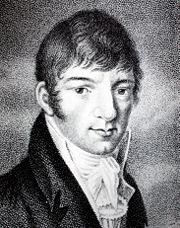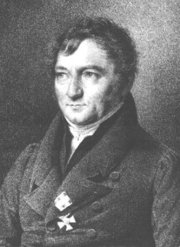
Martin Lichtenstein
Encyclopedia


Germany
Germany , officially the Federal Republic of Germany , is a federal parliamentary republic in Europe. The country consists of 16 states while the capital and largest city is Berlin. Germany covers an area of 357,021 km2 and has a largely temperate seasonal climate...
physician
Physician
A physician is a health care provider who practices the profession of medicine, which is concerned with promoting, maintaining or restoring human health through the study, diagnosis, and treatment of disease, injury and other physical and mental impairments...
, explorer, zoologist, and herpetologist.
Biography
Lichtenstein was the son of Anton August Heinrich LichtensteinAnton August Heinrich Lichtenstein
Anton August Heinrich Lichtenstein was a German zoologist. He was the father of Martin Hinrich Carl Lichtenstein....
, born in Hamburg
Hamburg
-History:The first historic name for the city was, according to Claudius Ptolemy's reports, Treva.But the city takes its modern name, Hamburg, from the first permanent building on the site, a castle whose construction was ordered by the Emperor Charlemagne in AD 808...
. He studied medicine
Medicine
Medicine is the science and art of healing. It encompasses a variety of health care practices evolved to maintain and restore health by the prevention and treatment of illness....
at Jena and Helmstedt
University of Helmstedt
The University of Helmstedt, official Latin name: Academia Julia , was a university in Helmstedt in the Duchy of Brunswick-Wolfenbüttel that existed from 1576 until 1810....
. Between 1802 and 1806 he travelled in southern Africa
Africa
Africa is the world's second largest and second most populous continent, after Asia. At about 30.2 million km² including adjacent islands, it covers 6% of the Earth's total surface area and 20.4% of the total land area...
, becoming the personal physician of the Governor of the Cape of Good Hope
Cape of Good Hope
The Cape of Good Hope is a rocky headland on the Atlantic coast of the Cape Peninsula, South Africa.There is a misconception that the Cape of Good Hope is the southern tip of Africa, because it was once believed to be the dividing point between the Atlantic and Indian Oceans. In fact, the...
. In 1810 he published Reisen im südlichen Afrika; as a result, he was appointed professor of zoology at the University of Berlin in 1811, and appointed director of the Berlin Zoological Museum in 1813. In 1829, he was elected a foreign member of the Royal Swedish Academy of Sciences
Royal Swedish Academy of Sciences
The Royal Swedish Academy of Sciences or Kungliga Vetenskapsakademien is one of the Royal Academies of Sweden. The Academy is an independent, non-governmental scientific organization which acts to promote the sciences, primarily the natural sciences and mathematics.The Academy was founded on 2...
.
He died after a duel fought at sea off Kiel
Kiel
Kiel is the capital and most populous city in the northern German state of Schleswig-Holstein, with a population of 238,049 .Kiel is approximately north of Hamburg. Due to its geographic location in the north of Germany, the southeast of the Jutland peninsula, and the southwestern shore of the...
.
Legacy
Lichtenstein was responsible for the creation of BerlinBerlin
Berlin is the capital city of Germany and is one of the 16 states of Germany. With a population of 3.45 million people, Berlin is Germany's largest city. It is the second most populous city proper and the seventh most populous urban area in the European Union...
's Zoological Gardens in 1841, when he persuaded King Frederick William IV of Prussia
Frederick William IV of Prussia
|align=right|Upon his accession, he toned down the reactionary policies enacted by his father, easing press censorship and promising to enact a constitution at some point, but he refused to enact a popular legislative assembly, preferring to work with the aristocracy through "united committees" of...
to donate the grounds of his pheasantry. He also published Johann Reinhold Forster
Johann Reinhold Forster
Johann Reinhold Forster was a German Lutheran pastor and naturalist of partial Scottish descent who made contributions to the early ornithology of Europe and North America...
's manuscripts for Descriptiones animalium in 1844.
In the field of herpetology
Herpetology
Herpetology is the branch of zoology concerned with the study of amphibians and reptiles...
he described many new species
Species
In biology, a species is one of the basic units of biological classification and a taxonomic rank. A species is often defined as a group of organisms capable of interbreeding and producing fertile offspring. While in many cases this definition is adequate, more precise or differing measures are...
of amphibians and reptiles.
Among species named by Lichtenstein are included the Australian King Parrot
Australian King Parrot
The Australian King Parrot is endemic to eastern Australia. It is found in humid and heavily forested upland regions of the eastern portion of the continent, including eucalyptus wooded areas in and directly adjacent to subtropical and temperate rainforest...
(Alisterus scapularis) and the Cape night adder (Causus rhombeatus
Causus rhombeatus
Causus rhombeatus is a venomous viper species found in subsaharan Africa. No subspecies are currently recognized.-Description:With an average length of 60 cm, this is the largest member of the genus Causus. The longest individual ever recorded was a 93 cm male collected in eastern Zimbabwe.The head...
Lichtenstein, 1823).
In 1859 Italian
Italy
Italy , officially the Italian Republic languages]] under the European Charter for Regional or Minority Languages. In each of these, Italy's official name is as follows:;;;;;;;;), is a unitary parliamentary republic in South-Central Europe. To the north it borders France, Switzerland, Austria and...
herpetologist, Giorgio Jan
Giorgio Jan
Giorgio Jan was an Italian taxonomist, zoologist, botanist, herpetologist, and writer. He is also known as Georg Jan or Georges Jan....
, named the forest night adder (Causus lichtensteinii
Causus lichtensteinii
Causus lichtensteinii is a venomous viper species found in western and central Africa. No subspecies are currently recognized. The specific name, or epithet, "lichtensteinii", honors German herpetologist Martin Hinrich Lichtenstein.-Description:...
) in honor of Martin Lichtenstein.

